Mindprint DTC Dual Tube 2 channel high-end mastering preamp EQ valve compressor
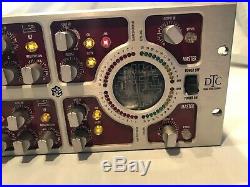
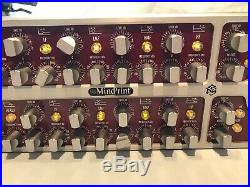

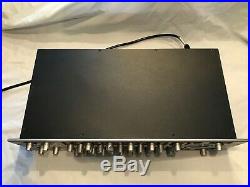
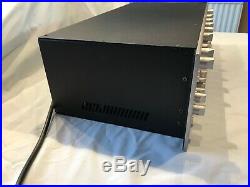
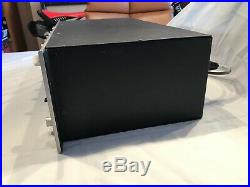
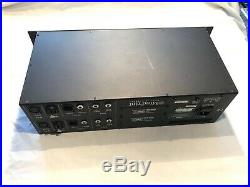
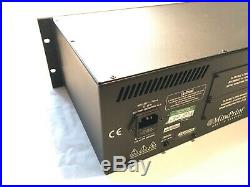
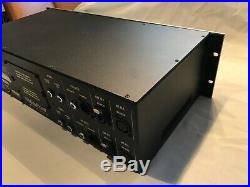
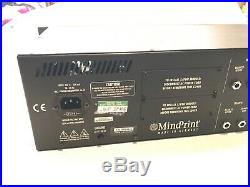
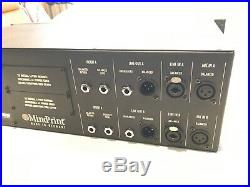

Great sounding 2 channel mic pre with line inputs, extremely comprehensive EQ with adjustable high and low pass filters, all bands can be switched in or out and valve compressor with filter on sidechain and stereo link. Particularly good for mastering or putting across the 2-bus.
This is in brilliant condition with hardly any marks on it and very little rack rash. This unit does not have the digital inputs or outputs but they are still available new from mind print. A review of the unit.
The new flagship of the Mindprint range provides a powerful combination of preamp, EQ and valve dynamics. Can it possibly sound as good as it looks? The Mindprint DTC is a two-channel unit equipped with high-quality mic preamps (with line and instrument inputs), unusually comprehensive equalisation, and basic dynamics. Valves are used within the dynamics circuitry a pair of ECC83 triodes to be precise but this is primarily a solid-state device with large numbers of op-amps scattered around the internal circuit boards. The DTC can also be fitted with an optional DI-Mod 24/96 high-resolution A-D/D-A converter module (see'Optional Digital I/O' box for more details).
It can therefore serve as a high-quality front end for a digital workstation or as a mastering processor, and can also translate from one digital format to another through the analogue domain. The chunky 3U rackmount box has a substantial milled front panel with recessed sections to delineate the control groups. It weighs around 6.5kg and measures about 220mm deep. It seems to run quite warm, as the only ventilation is a few slots on the rear panel. The numerous connectors are well spaced and clearly identified on the back panel: an XLR for the mic input, a combi TRS jack/XLR socket for the line input, and both XLR and quarter-inch jack sockets for the line output (balanced and unbalanced respectively).A further pair of TRS jack sockets provide a balanced insert. The microphone input employs a custom transformer with a bandwidth extending between 5Hz and 127kHz (±3dB). The input stage can tolerate a maximum input of +30dBu (with the front-panel 20dB pad switched in) and the EIN (equivalent input noise) is claimed to be an impressive -131dB measured at maximum gain with a 150 source.
Distortion is never worse than 0.09 percent (at +20dB, 100Hz) and usually an order of magnitude better. The line input is electronically balanced and floating, and the instrument input (on the front panel) offers an input impedance of 2.2M. The main output is electronically balanced and floating and is able to drive to +25dBu. The unique design has a 1:5 turns ratio which provides a relatively high input impedance of 5k, but is claimed to give a better sound, particularly with ribbon and moving coil mics, because of the reduced loading.
The high turns ratio also provides a voltage step-up, providing a degree of'free gain' which eases the workload of the mic amplifier, reducing distortion and noise. The microphone gain control is calibrated from +20dB to +72dB and is accompanied by illuminated switches to select the microphone input, phantom power, and a 20dB pad. Another button selects the digital input (if installed) in place of the line input, and an associated level control ranges from'off' to +16dB.
This control also affects the instrument input (which overrides the line and digital inputs). Two more buttons introduce a polarity inversion and the insert loop, while another changes the metering between input and output levels. The majority of the remaining circuitry is given over to the equaliser, with no fewer than 14 rotary controls and six illuminated buttons.
The four-band parametric design incorporates independent high- and low-pass filtering, and bypass switching for each individual band. The 24dB/octave high-pass filter is tuneable from 22Hz to 220Hz, while the 12dB/octave low-pass ranges from 3kHz to 30kHz. The top and bottom parametric bands are shelving types, with variable corner frequencies plus a Q control which alters the shape of the response through the transition region. Low Q settings provide the usual gentle 6dB/octave progression from unity gain to the shelf level (up to ±15dB), but high Q settings create a much steeper 24dB/octave transition along with a'kink'. For example, applying 6dB of boost at 10kHz with a high Q setting will create a frequency response which initially dips a few dBs below unity gain before rising steeply to the shelf level.Turning the boost/cut control down to apply 6dB of cut reverses this trend, so that a small peak is introduced into the response before the shelf cut. This unusual characteristic allows a much broader range of EQ shapes to be created than is possible with a fixed-Q shelf. The turnover of the low shelf is tuneable between 22Hz and 700Hz, while the high shelf ranges between 840Hz and 30kHz. The two centre bands have a standard Q control to change the bandwidth over which the'bell' operates.
The lower mid-band spans centre frequencies between 47Hz and 1.6kHz, and the gain control provides up to +15dB of boost but -25dB of cut the latter always in a notch shape. The bandwidth is adjustable from six octaves down to 1/6 of an octave. The higher mid-band is tuneable from 190Hz to 13kHz with the same gain and Q settings.Unlike most standard EQ sections where the input signal passes through each EQ band in series, the DTC is apparently configured so that each of the four bands operate in parallel. All filter bands receive the input signal and their outputs are added or subtracted from the main signal to provide the desired boost or cut. This is claimed to preserve signal quality by avoiding unnecessary filtering circuitry an unusual approach, but one which certainly seems to work well in the DTC.
The dynamics section looks deceptively simple, with just two controls labelled Limit and Release. The first is a combined threshold, ratio, and make-up gain control, while the second is self-explanatory, ranging from 20ms to 2s. The dynamics circuitry employs an opto-coupler in the compressor path, with a triode valve to provide the limiting and gain make-up. The transition from compression into limiting is very gentle with a soft-knee slope, and the attack time is determined by a feature called'Adaptive Response' which adjusts the attack time between 5ms and 50ms depending on the material. The operation of the Limit control is unusual since at the extreme left-hand position it limits only at high signal levels.
The threshold falls as the knob is turned clockwise until, at 12 o'clock, it is claimed to act as a brick-wall limiter set to 0dBFS, although I found it tended to -3dBFS. Rotating the Limit control further clockwise lowers the threshold, moving into more gentle compression curves with softer ratio slopes. Three illuminated buttons provide a dynamics bypass, stereo link and side-chain filter facilities. The last of these introduces an equaliser into the side chain which reduces signals below 300Hz by 6dB/octave. This makes the unit less sensitive to low-frequency energy, and so the amount of compression is weighted more by the mid-range frequencies which sounds a lot more natural and suffers fewer bass-driven pumping artefacts. Finally, the output section contains a level control, a meter and an overall bypass switch which removes the insert loop, equaliser, and dynamics from the signal path, but retains the input conditioning. The level range provides +6dB of gain at the right-hand end, and reduces to silence at the opposite extreme. The metering is another unusual design, with a pair of level bar-graphs forming the right-hand quadrants of a circle, and the corresponding gain-reduction meters forming the left quadrants. They therefore appear to work in opposition and I found the display very attractive. In the centre of the metering a clear window etched with the Mindprint logo provides a vista of the two triodes glowing gently within. The DTC is a fine processor with a very high-quality mic preamp, line input and instrument stage (all with superb noise and distortion characteristics) and a wide-open, clean-sounding nature.The equaliser was a joy to use once the layout of controls had been learned with fourteen identical knobs in such close proximity it is very easy to tweak the wrong one by mistake. The EQ is very musical even at extreme settings allowing subtle creative shaping of an instrument's tonal colour, as well as surgical removal of unwanted resonances, if required. The shelf stages are particularly interesting and powerful, often obviating the mid-bands thanks to their unusual Q controls, while the top end gave a real feeling of'air' when boosting with the shelf turnover above 15kHz. The DTC makes a powerful mastering processor for shaping the overall tonal balance of a mix and applying gentle overall compression.
I also found the ability to accommodate different sample rates between input and output handy but be warned that the output word length cannot be changed from 24 bits. Outputting to a DAT or CD-R machine will result in nasty truncation distortion at the 16th bit level a problem which Mindprint should address urgently. The DTC may appear expensive in the UK, but whereas most front ends are single-channel units, this offers two complete channels, allowing stereo recording and mastering applications. The mic stage is quiet, detailed and smooth, the EQ is fabulous, and the dynamics are a useful aid. All in all, an impressive unit which should do well.
Collection from London SE25 cash on collection where unit can be auditioned. The item "Mindprint DTC Dual Tube 2 channel high-end mastering preamp EQ valve compressor" is in sale since Wednesday, October 31, 2018. This item is in the category "Musical Instruments\Pro Audio Equipment\Preamps".
The seller is "stringy19" and is located in London. This item can be shipped to United Kingdom, Austria, Belgium, Denmark, France, Germany, Ireland, Italy, Luxembourg, Netherlands, Poland, Spain, Sweden, United States, Canada, Japan, Hong Kong, Norway, Singapore, Switzerland.
- Anzahl der Kanäle: Mindprint DTC Dual Tube Channel Mic Preamp Miktofo
- Besonderheiten: Elektronenröhre
- Marke: MindPrint
- Modell: Mindprint DTC Dual Tube Channel Mic Preamp Miktofo
- Brand: Mindprint
- Number of Channels: 2
- Model: DTC
